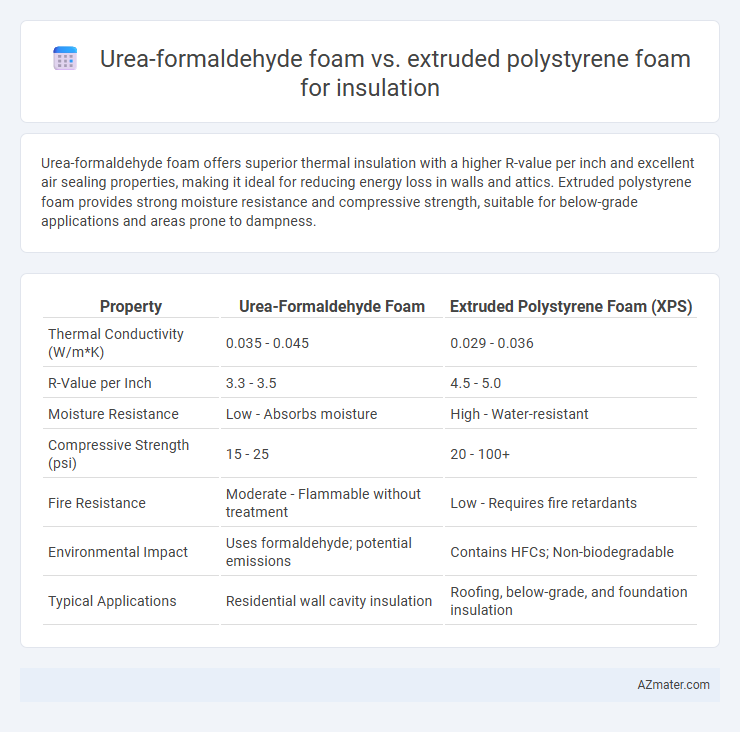Urea-formaldehyde foam offers superior thermal insulation with a higher R-value per inch and excellent air sealing properties, making it ideal for reducing energy loss in walls and attics. Extruded polystyrene foam provides strong moisture resistance and compressive strength, suitable for below-grade applications and areas prone to dampness.
Table of Comparison
| Property | Urea-Formaldehyde Foam | Extruded Polystyrene Foam (XPS) |
|---|---|---|
| Thermal Conductivity (W/m*K) | 0.035 - 0.045 | 0.029 - 0.036 |
| R-Value per Inch | 3.3 - 3.5 | 4.5 - 5.0 |
| Moisture Resistance | Low - Absorbs moisture | High - Water-resistant |
| Compressive Strength (psi) | 15 - 25 | 20 - 100+ |
| Fire Resistance | Moderate - Flammable without treatment | Low - Requires fire retardants |
| Environmental Impact | Uses formaldehyde; potential emissions | Contains HFCs; Non-biodegradable |
| Typical Applications | Residential wall cavity insulation | Roofing, below-grade, and foundation insulation |
Introduction to Urea-Formaldehyde and Extruded Polystyrene Foams
Urea-formaldehyde foam is a thermosetting resin-based insulation material known for its high insulating value and excellent air-sealing properties, often used in wall cavities and attic floors. Extruded polystyrene foam (XPS) is a rigid, closed-cell insulation with superior moisture resistance and compressive strength, commonly applied in below-grade and roofing applications. Both foams offer distinct thermal performance, durability, and moisture management characteristics suited to specific insulation needs in residential and commercial construction.
Composition and Chemical Structure Comparison
Urea-formaldehyde foam is composed of synthetic polymers derived from urea and formaldehyde, forming a thermosetting resin characterized by a cross-linked network structure that provides rigidity and thermal insulation. Extruded polystyrene foam consists of polystyrene polymers with a closed-cell structure, offering excellent moisture resistance and thermal insulation through a stable, hydrophobic matrix of long hydrocarbon chains. The chemical structure of urea-formaldehyde foam features nitrogen and oxygen atoms in its polymer network, while extruded polystyrene foam is primarily hydrocarbon-based, affecting their respective thermal properties and durability.
Insulation Performance and Thermal Conductivity
Urea-formaldehyde foam offers an R-value of approximately 3.7 per inch, providing moderate insulation with a thermal conductivity near 0.27 W/m*K, making it suitable for filling cavities and sealing gaps. Extruded polystyrene (XPS) foam delivers a higher R-value around 5 per inch and lower thermal conductivity approximately 0.029 W/m*K, ensuring superior resistance to heat flow and enhanced moisture resistance. XPS's closed-cell structure outperforms urea-formaldehyde foam in maintaining long-term insulation performance, especially in environments with higher humidity.
Moisture Resistance and Water Absorption
Urea-formaldehyde foam exhibits higher water absorption rates due to its porous structure, making it less effective in moisture resistance compared to extruded polystyrene foam. Extruded polystyrene foam features a closed-cell structure that provides superior resistance to water absorption, enhancing its performance in damp environments. This characteristic makes extruded polystyrene foam a preferred choice for insulation applications requiring robust moisture resistance and long-term durability.
Fire Resistance and Safety Ratings
Urea-formaldehyde foam insulation offers moderate fire resistance with a flame spread rating typically around 75 to 150, but it can release toxic gases when exposed to high heat, raising safety concerns. Extruded polystyrene foam (XPS) exhibits a lower flame spread rating, often below 75, which indicates better fire resistance, though it is combustible and requires fire retardant additives or protective barriers for compliance with building codes. Safety ratings favor XPS for structural fire safety when properly installed, while urea-formaldehyde foam requires careful consideration of ventilation and fire suppression measures due to its potential toxic emissions.
Installation Methods and Application Areas
Urea-formaldehyde foam insulation is typically installed through injection or spray-in-place methods, making it ideal for filling cavities in existing walls and attic spaces with irregular shapes. Extruded polystyrene foam (XPS) is commonly applied as rigid boards, fastened mechanically or with adhesives, making it suitable for continuous insulation on exterior walls, roofs, and below-grade applications. The moisture resistance and compressive strength of XPS make it preferable for foundation walls and below-grade insulation, while urea-formaldehyde foam excels in retrofit projects requiring detailed cavity filling.
Durability and Longevity of Insulation
Urea-formaldehyde foam insulation tends to have a shorter lifespan due to its susceptibility to moisture absorption and potential for shrinkage or cracking over time. Extruded polystyrene foam (XPS) offers superior durability with high resistance to water, compression, and chemical damage, enabling it to maintain insulation performance for several decades. The long-term stability of XPS makes it a preferred choice in environments where insulation longevity and structural integrity are critical.
Environmental Impact and Sustainability
Urea-formaldehyde foam releases lower global warming potential (GWP) gases during production compared to extruded polystyrene foam, which emits potent hydrofluorocarbons (HFCs) contributing to ozone depletion and climate change. Urea-formaldehyde is partially derived from renewable resources and is more biodegradable, whereas extruded polystyrene is petroleum-based, non-biodegradable, and challenging to recycle. Choosing urea-formaldehyde foam insulation contributes to reduced environmental pollution and promotes sustainability through lower carbon footprint and improved end-of-life disposal options.
Cost Analysis and Economic Considerations
Urea-formaldehyde foam insulation typically offers lower initial material and installation costs compared to extruded polystyrene foam, making it a budget-friendly option for residential projects. However, extruded polystyrene foam, with its higher R-value per inch and superior moisture resistance, may lead to long-term energy savings and reduced maintenance expenses despite the higher upfront price. Economic considerations should include lifecycle cost analysis, factoring in potential energy efficiency gains and durability differences between the two insulation materials.
Conclusion: Choosing the Right Foam for Effective Insulation
Urea-formaldehyde foam offers excellent thermal insulation with superior air sealing properties, making it ideal for filling irregular cavities and reducing energy loss. Extruded polystyrene foam provides high compressive strength and moisture resistance, suitable for below-grade applications and areas exposed to damp conditions. Selecting the right foam depends on specific insulation needs, including environmental exposure, structural requirements, and long-term durability considerations.

Infographic: Urea-formaldehyde foam vs Extruded polystyrene foam for Insulation
 azmater.com
azmater.com